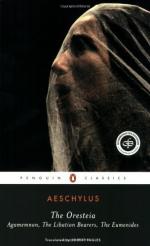|
This section contains 5,752 words (approx. 20 pages at 300 words per page) |

|
SOURCE: "Sexual and Political Conflict in the Oresteia," in Aeschylean Drama, University of California Press, 1976, pp. 87-118.
In the following excerpt, Gagarin investigates Aeschylus's depiction of gender roles and sexual conflict in the Oresteia.
That there is sexual conflict in some sense in the Oresteia is obvious, since the basic pattern of action and retributive reaction (drasanti pathein) unfolds in the trilogy as an alternation of male and female agents: Agamemnon, Clytemnestra, Orestes, and the Furies. This fact in itself might not be very significant, but, as we shall see, sexual conflict in the form of debate over male and female values occurs throughout the trilogy. Particularly notable are the concluding arguments of Apollo in Eumenides (625-28 and especially 657-66) and the reasons given by Athena for favoring Orestes' case (736-40), which are based almost entirely on sexual considerations, namely that the male is superior to the female...
|
This section contains 5,752 words (approx. 20 pages at 300 words per page) |

|


